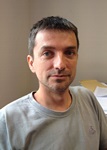Org. Synth. 2013, 90, 301-305
DOI: 10.15227/orgsyn.090.0301
Preparation of DABSO from Karl-Fischer reagent
Submitted by Ludovic Martial and Laurent Bischoff.
*1.
Checked by Changming Qin and Huw M. L. Davies.
1. Procedure
Caution: Karl-Fischer reagent A, which consists of a pyridine-sulfur dioxide solution in methanol, should be used under a well-ventilated fume hood.
1,4-Diazabicyclo[2,2,2]octane bis (sulfur dioxide) adduct. An oven-dried 500-mL round-bottomed flask containing a 5 cm Teflon-coated oval stir bar is fitted with a rubber septum and allowed to cool to room temperature under vacuum (Note 1). At room temperature (22 °C), 1,4-diazabicyclo[2,2,2]octane (DABCO) (15.0 g, 134 mmol, 1 equiv) (Note 2) is added and the flask is connected to a vacuum line via a needle inserted through the septum. The flask is evacuated then back-filled with argon. This process is repeated three times. Dry THF (180 mL) (Note 3) is introduced via syringe under a positive argon pressure. After complete dissolution, the reaction medium is ice-cooled and Karl-Fischer reagent (solution A, 120 mL, ~280 - 375 mmol SO2) (Note 4) is added dropwise via syringe at 0 °C (external temperature) over 30 min. Precipitation of DABSO is observed shortly after the addition is initiated. After stirring 30 min at 0 °C, the ice-bath is removed and the suspension is stirred at room temperature for an additional 3 h. The suspension is filtered through a 250-mL sintered-glass funnel under reduced pressure (vacuum pump, 15 mmHg). The white solid is washed on the funnel by triturating a few seconds with diethyl ether (50 mL) (Note 5) without suction. The collected solid is transferred back to the original 500-mL flask. Diethyl ether (200 mL) is added and the suspension is stirred at room temperature for 15 min under a nitrogen atmosphere. The solid is collected on the same sintered-glass funnel. The re-slurry procedure is repeated twice in the same manner. Since DABSO is a hygroscopic solid, it is immediately transferred into a 250-mL round-bottomed flask and dried in a desiccator under vacuum for 12 h (Note 6) to afford DABSO (30.9-31.0 g, 96-97%) as a colorless powder (Note 7).
2. Notes
1. The apparatus is dried in an oven at > 70 °C overnight and cooled to room temperature under vacuum (0.2 mmHg).
2.
DABCO (95 %) was purchased from Sigma-Aldrich and used as received from a freshly opened bottle. The submitters report that older samples of
DABCO can be purified by recrystallization (Armarego, W. L.F.; Chai, C. L. L.
Purification of Laboratory Chemicals (5th Edition),
2003, Elsevier, p 191).
3. Anhydrous
THF (99.9%) was obtained from Acros and used as received.
4. Karl-Fischer reagent (reagent for volumetric two-component KF titration, pyridine-containing working medium, solution A: pyridine-sulfur dioxide) was purchased from Fluka (Sigma-Aldrich) and used as received. This reagent contains approximately15-20% SO
2.
5. Anhydrous
diethyl ether (99.0%) was obtained from Fisher Scientific and used as received.
6.
Phosphorus pentoxide (15 g) was placed in the desiccator and the product was dried under high vacuum (~ 0.05 mmHg).
7.
1,4-Diazabicyclo[2,2,2]octane bis (sulfur dioxide) adduct has the following physical and spectroscopic properties:mp 141-143 °C; IR: ν (cm
-1): 3400, 2962, 2892, 2802, 1651, 1465, 1324, 1178, 1053, 999, 949, 842, 804, 785, 718;
1H NMR
pdf (400 MHz, CD
3OD) δ: 3.21 (s) ;
13C NMR
pdf (100 MHz, CD
3OD) δ: 45.6; Anal calcd: C 29.99, H 5.03, N 11.66; found C 30.38, H 5.06, N 11.58.
Handling and Disposal of Hazardous Chemicals
The procedures in this article are intended for use only by persons with prior training in experimental organic chemistry. All hazardous materials should be handled using the standard procedures for work with chemicals described in references such as "Prudent Practices in the Laboratory" (The National Academies Press, Washington, D.C., 2011 www.nap.edu). All chemical waste should be disposed of in accordance with local regulations. For general guidelines for the management of chemical waste, see Chapter 8 of Prudent Practices.
These procedures must be conducted at one's own risk. Organic Syntheses, Inc., its Editors, and its Board of Directors do not warrant or guarantee the safety of individuals using these procedures and hereby disclaim any liability for any injuries or damages claimed to have resulted from or related in any way to the procedures herein.
3. Discussion
DABSO consists of a 1:2 complex between
DABCO and
sulfur dioxide. This reagent has recently found an increasing number of applications, such as sulfonamide formation
via palladium coupling, synthesis of sulfonylureas, etc.
2, 3, 4 It consists of a white, stable, however hygroscopic powder, and its handling is much more convenient and safer than gaseous
sulfur dioxide. In addition, the regulations concerning the transportation and storage of gaseous
sulfur dioxide render its replacement with
DABSO even more useful. However,
DABSO is an expensive commercially-available reagent, generally sold in small gram-scale amounts, and is currently sold by few chemical suppliers. Its preparation has been described in the literature,
5 either as isolated
DABSO itself, or prepared
in situ. In each case gaseous
sulfur dioxide was either condensed or bubbled through a solution of
DABCO. These procedures required a large excess of toxic
sulfur dioxide, which should be trapped to avoid discarding in the atmosphere.
We herein report a safe and cheap alternative for the preparation of DABSO, using commercially-available Karl-Fischer reagent as the source of sulfur dioxide. Care must be taken when purchasing the solution, since both volumetric and coulometric titration solutions exist. The coulometric solution, containing iodide, SO2, pyridine in methanol should not be used for DABSO preparation in order to avoid iodide-contamination of the resulting DABSO. When a SO2-pyridine solution in methanol is used (sold as 'solution A'), no trace of pyridine nor methanol is observed.
Since the SO2 concentration (15-20%) is not accurately provided by the supplier, DABCO is used as the limiting reagent. With the use of a higher DABCO:SO2 molar ratio, yields of DABSO might be improved; however, we preferred to ensure an excess SO2 is used to avoid contamination of DABSO with residual DABCO.
Thus, when a THF solution of DABCO is treated with a Karl-Fischer solution, precipitation of DABSO occurs almost immediately. Following filtration and washing of the solid with ether to remove pyridine, methanol and THF, clean DABSO is obtained. The reagent is stable enough to afford drying under vacuum without loss of SO2.
Appendix
Chemical Abstracts Nomenclature; (Registry Number)
1,4-Diazabicyclo[2,2,2]octane bis (sulfur dioxide) adduct (119752-83-9)
1,4-Diazabicyclo[2.2.2]octane (280-57-9)

|
Laurent Bischoff was born in France in 1969. After a Ph-D thesis in J.P. Genet laboratory (E.N.S.C.P. - Université Paris 6), he worked at a post-doctoral fellow in the laboratory pf Pr. J.E. Baldwin (Oxford, U.K., total synthesis of Manzamine fragments). After 8 years as an associate professor at the Faculty of Pharmacy of Paris (group of Pr. Roques then Pr. C. Garbay, working on metalloenzyme then phosphatase inhibitors), he moved in 2003 to Rouen for a professor position, now studying new tools for heterocyclic chemistry, and some extensions of the Mitsunobu reaction.
|

|
Ludovic Martial was born in France in 1986. He received his BSC in Molecular Chemistry at the University of Aix-Marseille III, and his MSC in Physics and Chemistry of Medicines at the University of Rouen. He's now ongoing his Ph-D research at the University of Rouen under the guidance of Professor Laurent Bischoff.
|

|
Changming Qin was born in Shandong, China in 1982. He did his undergraduate work at Ludong University on the preparation of polymer nanocomposites under the guidance of Prof. Yucai Hu. He obtained his Masters degree in organic chemistry in 2008 at Wenzhou University under the supervision of Prof. Huayue Wu, working on palladium-catalyzed transformations of aryl boronic acids. After graduation, he worked at the University of Hong Kong with Prof. Chi-Ming Che in 2008-2009, and then joined Prof. Huw Davies' group at Emory University in 2010. His current research is focused on design and synthesis of chiral dirhodium catalysts and their application in novel asymmetric carbeniod transformations.
|
Copyright © 1921-, Organic Syntheses, Inc. All Rights Reserved